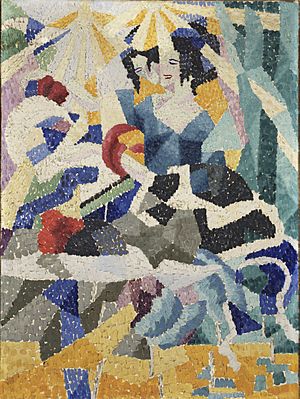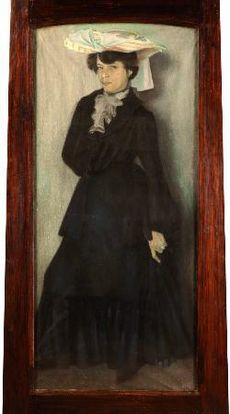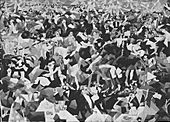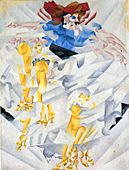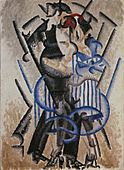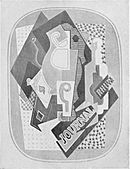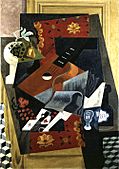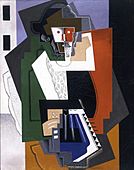Gino Severini facts for kids
Quick facts for kids
Gino Severini
|
|
|---|---|
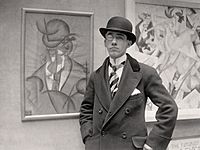
Gino Severini, aged 30, at the opening of his solo exhibition, Marlborough Gallery, London, 1913
|
|
| Born | 7 April 1883 Cortona, Kingdom of Italy
|
| Died | 26 February 1966 (aged 82) Paris, France
|
| Nationality | Italian |
| Education | Rome Fine Art Institute |
| Known for | Painting, mosaic, fresco |
|
Notable work
|
Pan Pan Dance, Dynamic Hieroglyph of the Bal Tabarin, Italian Lancers at a Gallop, Maternity, Conségna delle Chieve |
| Movement | Divisionism, Futurism, Cubism, Return to order, Neo-Classicism, Novecento Italiano |
| Awards | Premio Nazionale di Pittura of the Accademia di San Luca, Rome |
Gino Severini (born April 7, 1883 – died February 26, 1966) was an Italian painter. He was a very important artist in the Futurist art movement. He spent a lot of his life living and working in both Paris, France, and Rome, Italy.
After World War I, he also became known for a style called neo-classicism and a "return to order" in art. This meant going back to more traditional ways of painting. He created art using many different materials, like mosaics (pictures made from small pieces of colored glass or stone) and frescoes (paintings done on wet plaster walls). His art was shown in big exhibitions, and he even won awards for his work.
Contents
Early Life and Art Beginnings
Gino Severini was born in Cortona, Italy, into a family that didn't have much money. His father worked for the court, and his mother was a dressmaker. He went to school in Cortona until he was fifteen. Then, he and some friends were kicked out of all Italian schools for trying to steal exam papers. Gino never went back to formal school after that.
For a while, he worked with his father. In 1899, he moved to Rome with his mother. There, he started to get very interested in art. He painted in his free time while working as a shipping clerk. He took art classes for two years, but then the person who was paying for his lessons stopped.
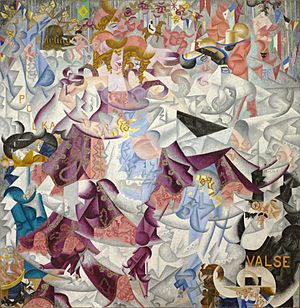
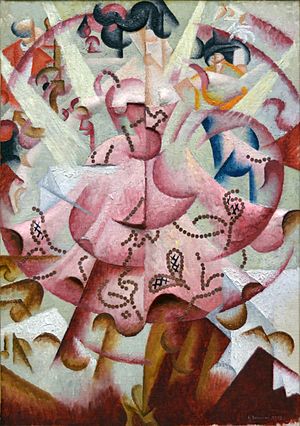
In 1900, he met another painter named Umberto Boccioni. They visited the studio of Giacomo Balla, who taught them about Divisionism. This was a painting technique where artists used small dots or stripes of pure color next to each other, instead of mixing them. This made the colors seem to blend in the viewer's eye. Divisionism had a big impact on Severini's early art and on Futurist painting from 1910 to 1911.
In November 1906, Severini moved to Paris, France. This move was very important for him. He later said that Cortona was where he was born physically, but Paris was where he grew intellectually and spiritually. He lived in Montmartre, a famous art district, and focused on painting. There, he met many rising artists of the time, like Amedeo Modigliani, Raoul Dufy, Georges Braque, and Pablo Picasso. He also knew writers and poets. Selling his art didn't earn him enough money to live, so he relied on generous supporters.
Joining the Futurist Movement
Severini was invited by Filippo Tommaso Marinetti and Umberto Boccioni to join the Futurist movement. He was one of the artists who signed the Manifesto of the Futurist Painters in February 1910. He also signed the Technical Manifesto of Futurist Painting in April of the same year.
He was an important link between artists in France and Italy. He learned about Cubism (an art style that breaks objects into geometric shapes) before his Futurist friends did. After visiting Paris in 1911, the Italian Futurists started using some Cubist ideas. This helped them show energy and movement in their paintings.
Severini helped organize the first Futurist art show outside Italy. It was at the Galerie Bernheim-Jeune in Paris in February 1912. He also took part in other Futurist shows in Europe and the United States. In 1913, he had his own art shows in London and Berlin. In London, he met and became friends with British artist C. R. W. Nevinson, who then decided to become a Futurist too.
In his autobiography, Severini wrote that the Futurists were happy with how their exhibition was received. However, some important art critics, like Guillaume Apollinaire, made fun of them. They said the Futurists were too proud and didn't know much about modern art. Severini later agreed with Apollinaire.
Severini was less interested in painting machines than other Futurists. He often chose dancers to show the Futurist ideas of movement in art. He was very good at painting lively city scenes, like Dynamic Hieroglyph of the Bal Tabarin (1912). During World War I, he created some great Futurist war art, such as Italian Lancers at a Gallop (1915).
New Styles: Cubism and Neo-classicism
In 1916, Severini moved away from Futurism. He painted several works in a more natural style, inspired by early Renaissance art. After World War I, Severini slowly stopped using the Futurist style. He painted in a Crystal Cubist style until 1920.
By 1920, he was using ideas of classical balance, based on the Golden Section, in his still lifes and figurative subjects. These subjects came from the traditional commedia dell'arte (an old Italian theater style). He became part of the "return to order" in art after the war. Paintings like The Two Pulchinellas (1922) show Severini's shift to a more traditional, thoughtful way of painting.
After 1920, Severini spent his time between Paris and Rome. In 1921, he was asked to paint murals for Montefugoni castle. That same year, he published a book called Du cubisme au classicisme, which explained his ideas about mathematical theories of harmony in art. The murals were finished in 1922.
He took part in art exhibitions in Rome in 1923 and 1925. He also showed his work in Milan with artists from the Novecento Italiano group in 1926 and 1929. From 1928, he started to include parts of Rome's classical landscape in his art. In 1935, he won first prize for painting at the Rome Quadrennial, with a whole room dedicated to his work. He also created murals using fresco and mosaic techniques in Switzerland, France, and Italy.
Later Years and Legacy
In the 1940s, Severini's art became semi-abstract, meaning it was partly based on real things but also used shapes and colors in new ways. In the 1950s, he returned to his Futurist themes: dancers, light, and movement. He created mosaics for a church in Freiburg and completed the Conségna delle Chiavi mosaic. His mosaics were shown in Paris, and he attended a conference about the history of mosaic art.
He received requests to decorate offices for airlines like KLM and Alitalia. He also took part in an exhibition called The Futurists, Balla - Severini 1912–1918 in New York. In Rome, he rebuilt his Pan Pan Dance mosaic, which had been destroyed during the war. He won a national painting award and had a solo exhibition in Rome.
Throughout his life, he wrote important essays and books about art. In 1946, he published his autobiography, The Life of a Painter.
Severini passed away in Paris on February 26, 1966, at the age of 82. He was buried in his hometown of Cortona.
Gallery of Works
-
Le Boulevard, 1911, oil on canvas, 63.5 x 91.5 cm, Estorick Collection, London
-
Dynamism of a Dancer (Dinamismo di una danzatrice, Ballerina di chahut), 1912, oil on canvas, 60 x 45 cm, Jucker Collection, Pinacoteca di Brera, Milan
-
Paintings by Gino Severini, 1911, Souvenirs de Voyage, Albert Gleizes, 1912, Man on a Balcony, L’Homme au balcon, Severini, 1912–13, Portrait de Mlle Jeanne Paul-Fort, Luigi Russolo, 1911–12, La Révolte. Les Annales politiques et littéraires, Le Paradoxe Cubiste, n. 1916, 14 March 1920
Public Art Collections
You can find Gino Severini's art in public collections at places like:
- Museum de Fundatie, Zwolle, Netherland
- Guggenheim Museum, New York
- Museum of Modern Art, New York
See also
 In Spanish: Gino Severini para niños
In Spanish: Gino Severini para niños


